Wenhui Tan
Think Silently, Think Fast: Dynamic Latent Compression of LLM Reasoning Chains
May 22, 2025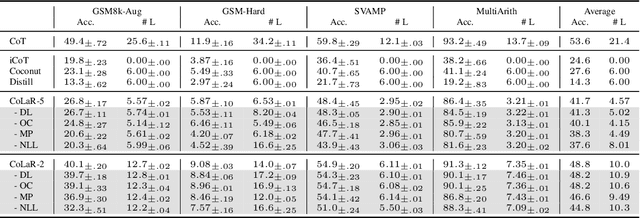


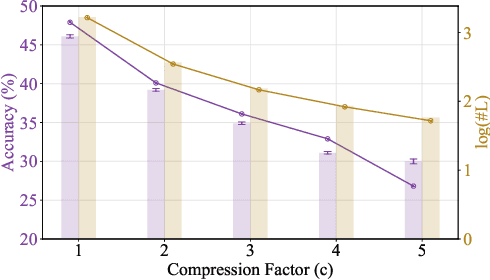
Abstract:Large Language Models (LLMs) achieve superior performance through Chain-of-Thought (CoT) reasoning, but these token-level reasoning chains are computationally expensive and inefficient. In this paper, we introduce Compressed Latent Reasoning (CoLaR), a novel framework that dynamically compresses reasoning processes in latent space through a two-stage training approach. First, during supervised fine-tuning, CoLaR extends beyond next-token prediction by incorporating an auxiliary next compressed embedding prediction objective. This process merges embeddings of consecutive tokens using a compression factor randomly sampled from a predefined range, and trains a specialized latent head to predict distributions of subsequent compressed embeddings. Second, we enhance CoLaR through reinforcement learning (RL) that leverages the latent head's non-deterministic nature to explore diverse reasoning paths and exploit more compact ones. This approach enables CoLaR to: i) perform reasoning at a dense latent level (i.e., silently), substantially reducing reasoning chain length, and ii) dynamically adjust reasoning speed at inference time by simply prompting the desired compression factor. Extensive experiments across four mathematical reasoning datasets demonstrate that CoLaR achieves 14.1% higher accuracy than latent-based baseline methods at comparable compression ratios, and reduces reasoning chain length by 53.3% with only 4.8% performance degradation compared to explicit CoT method. Moreover, when applied to more challenging mathematical reasoning tasks, our RL-enhanced CoLaR demonstrates performance gains of up to 5.4% while dramatically reducing latent reasoning chain length by 82.8%. The code and models will be released upon acceptance.
Multi-task Manipulation Policy Modeling with Visuomotor Latent Diffusion
Mar 12, 2024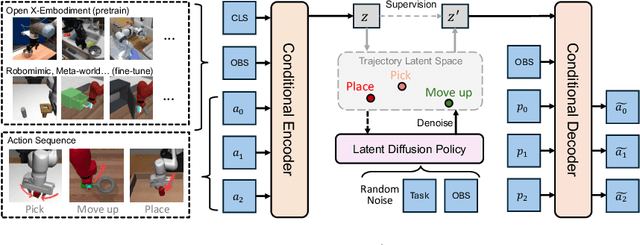
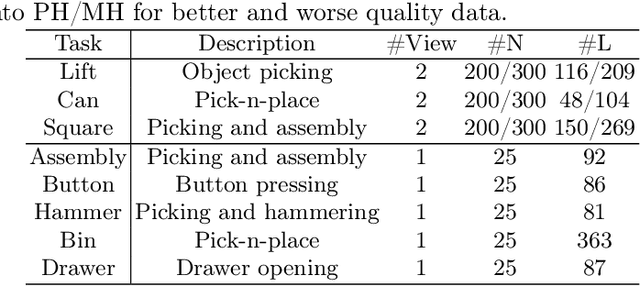
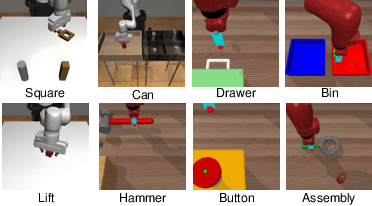
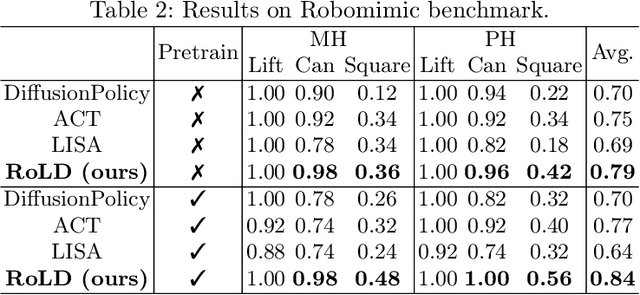
Abstract:Modeling a generalized visuomotor policy has been a longstanding challenge for both computer vision and robotics communities. Existing approaches often fail to efficiently leverage cross-dataset resources or rely on heavy Vision-Language models, which require substantial computational resources, thereby limiting their multi-task performance and application potential. In this paper, we introduce a novel paradigm that effectively utilizes latent modeling of manipulation skills and an efficient visuomotor latent diffusion policy, which enhances the utilizing of existing cross-embodiment and cross-environment datasets, thereby improving multi-task capabilities. Our methodology consists of two decoupled phases: action modeling and policy modeling. Firstly, we introduce a task-agnostic, embodiment-aware trajectory latent autoencoder for unified action skills modeling. This step condenses action data and observation into a condensed latent space, effectively benefiting from large-scale cross-datasets. Secondly, we propose to use a visuomotor latent diffusion policy that recovers target skill latent from noises for effective task execution. We conducted extensive experiments on two widely used benchmarks, and the results demonstrate the effectiveness of our proposed paradigms on multi-tasking and pre-training. Code is available at https://github.com/AlbertTan404/RoLD.
Pave the Way to Grasp Anything: Transferring Foundation Models for Universal Pick-Place Robots
Jun 25, 2023Abstract:Improving the generalization capabilities of general-purpose robotic agents has long been a significant challenge actively pursued by research communities. Existing approaches often rely on collecting large-scale real-world robotic data, such as the RT-1 dataset. However, these approaches typically suffer from low efficiency, limiting their capability in open-domain scenarios with new objects, and diverse backgrounds. In this paper, we propose a novel paradigm that effectively leverages language-grounded segmentation masks generated by state-of-the-art foundation models, to address a wide range of pick-and-place robot manipulation tasks in everyday scenarios. By integrating precise semantics and geometries conveyed from masks into our multi-view policy model, our approach can perceive accurate object poses and enable sample-efficient learning. Besides, such design facilitates effective generalization for grasping new objects with similar shapes observed during training. Our approach consists of two distinct steps. First, we introduce a series of foundation models to accurately ground natural language demands across multiple tasks. Second, we develop a Multi-modal Multi-view Policy Model that incorporates inputs such as RGB images, semantic masks, and robot proprioception states to jointly predict precise and executable robot actions. Extensive real-world experiments conducted on a Franka Emika robot arm validate the effectiveness of our proposed paradigm. Real-world demos are shown in YouTube (https://www.youtube.com/watch?v=1m9wNzfp_4E ) and Bilibili (https://www.bilibili.com/video/BV178411Z7H2/ ).
AlphaBlock: Embodied Finetuning for Vision-Language Reasoning in Robot Manipulation
May 30, 2023



Abstract:We propose a novel framework for learning high-level cognitive capabilities in robot manipulation tasks, such as making a smiley face using building blocks. These tasks often involve complex multi-step reasoning, presenting significant challenges due to the limited paired data connecting human instructions (e.g., making a smiley face) and robot actions (e.g., end-effector movement). Existing approaches relieve this challenge by adopting an open-loop paradigm decomposing high-level instructions into simple sub-task plans, and executing them step-by-step using low-level control models. However, these approaches are short of instant observations in multi-step reasoning, leading to sub-optimal results. To address this issue, we propose to automatically collect a cognitive robot dataset by Large Language Models (LLMs). The resulting dataset AlphaBlock consists of 35 comprehensive high-level tasks of multi-step text plans and paired observation sequences. To enable efficient data acquisition, we employ elaborated multi-round prompt designs that effectively reduce the burden of extensive human involvement. We further propose a closed-loop multi-modal embodied planning model that autoregressively generates plans by taking image observations as input. To facilitate effective learning, we leverage MiniGPT-4 with a frozen visual encoder and LLM, and finetune additional vision adapter and Q-former to enable fine-grained spatial perception for manipulation tasks. We conduct experiments to verify the superiority over existing open and closed-loop methods, and achieve a significant increase in success rate by 21.4% and 14.5% over ChatGPT and GPT-4 based robot tasks. Real-world demos are shown in https://www.youtube.com/watch?v=ayAzID1_qQk .
 Add to Chrome
Add to Chrome Add to Firefox
Add to Firefox Add to Edge
Add to Edge